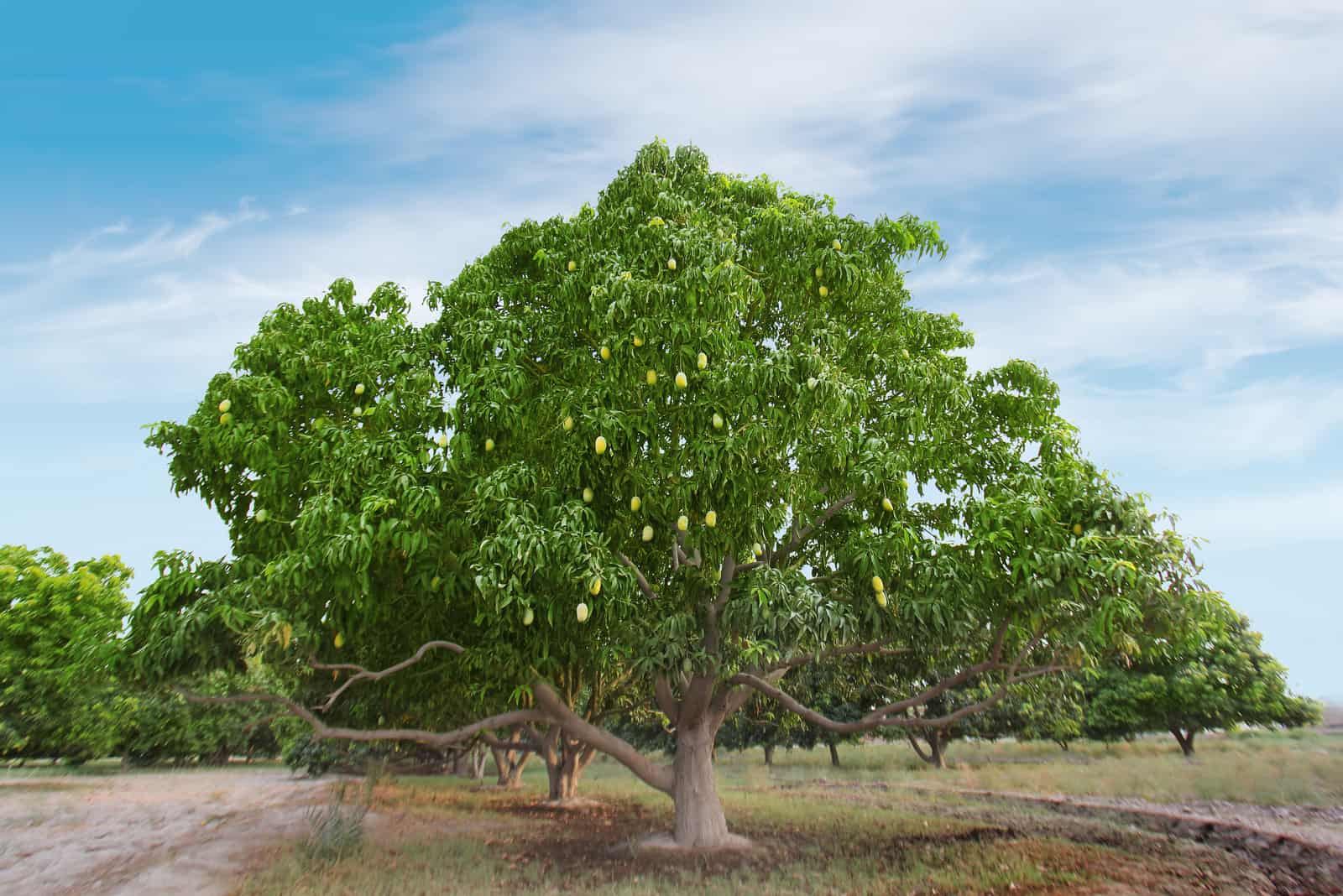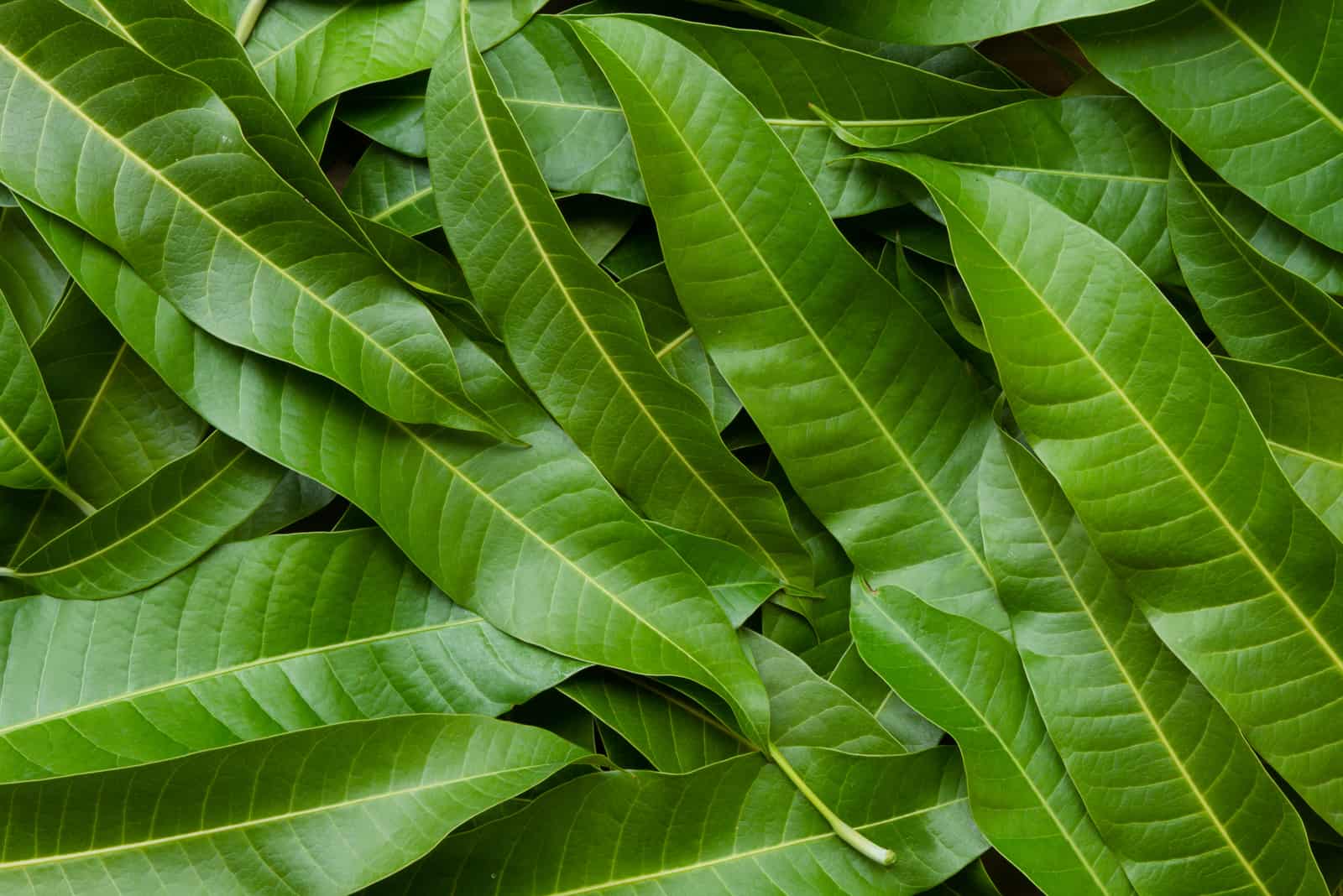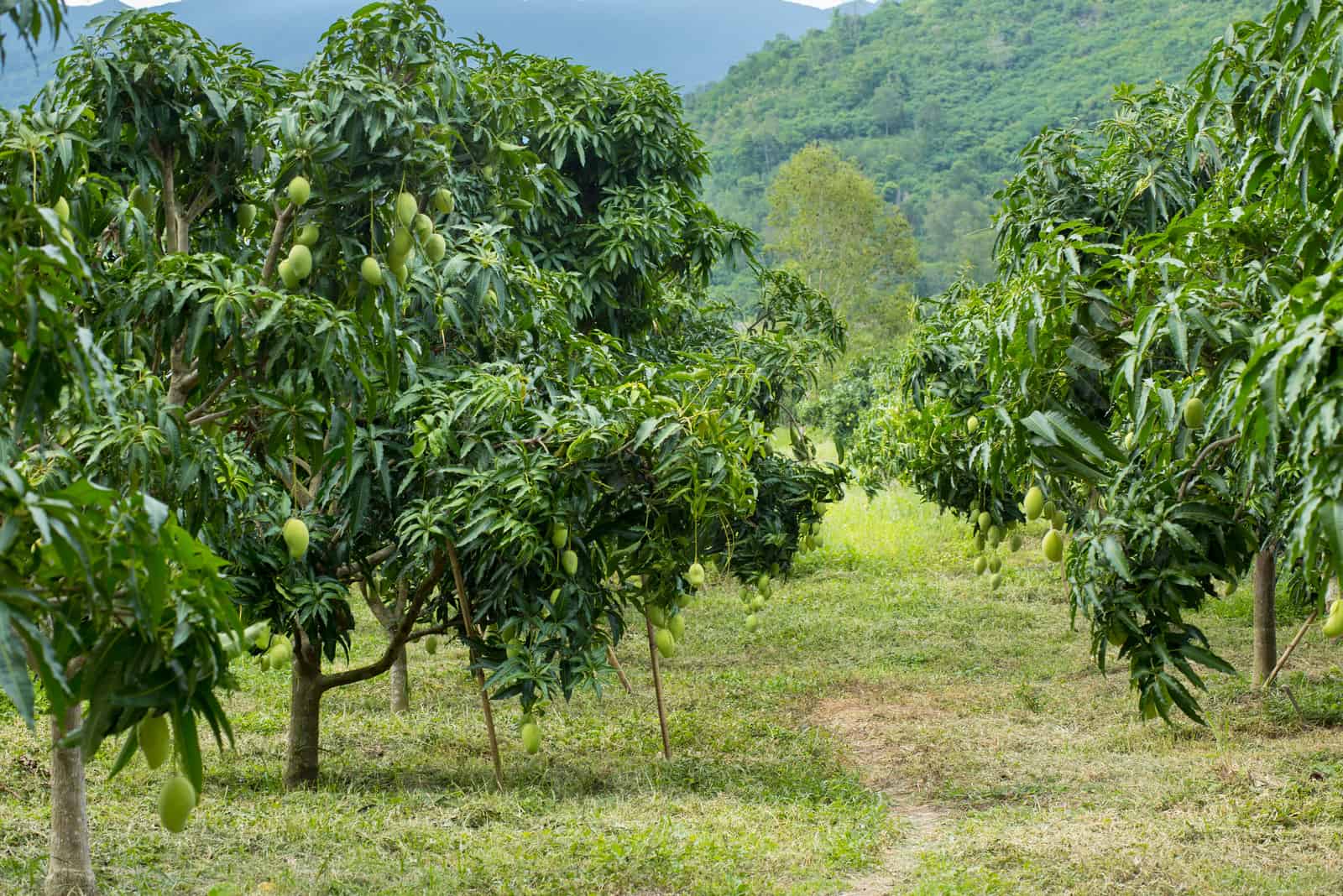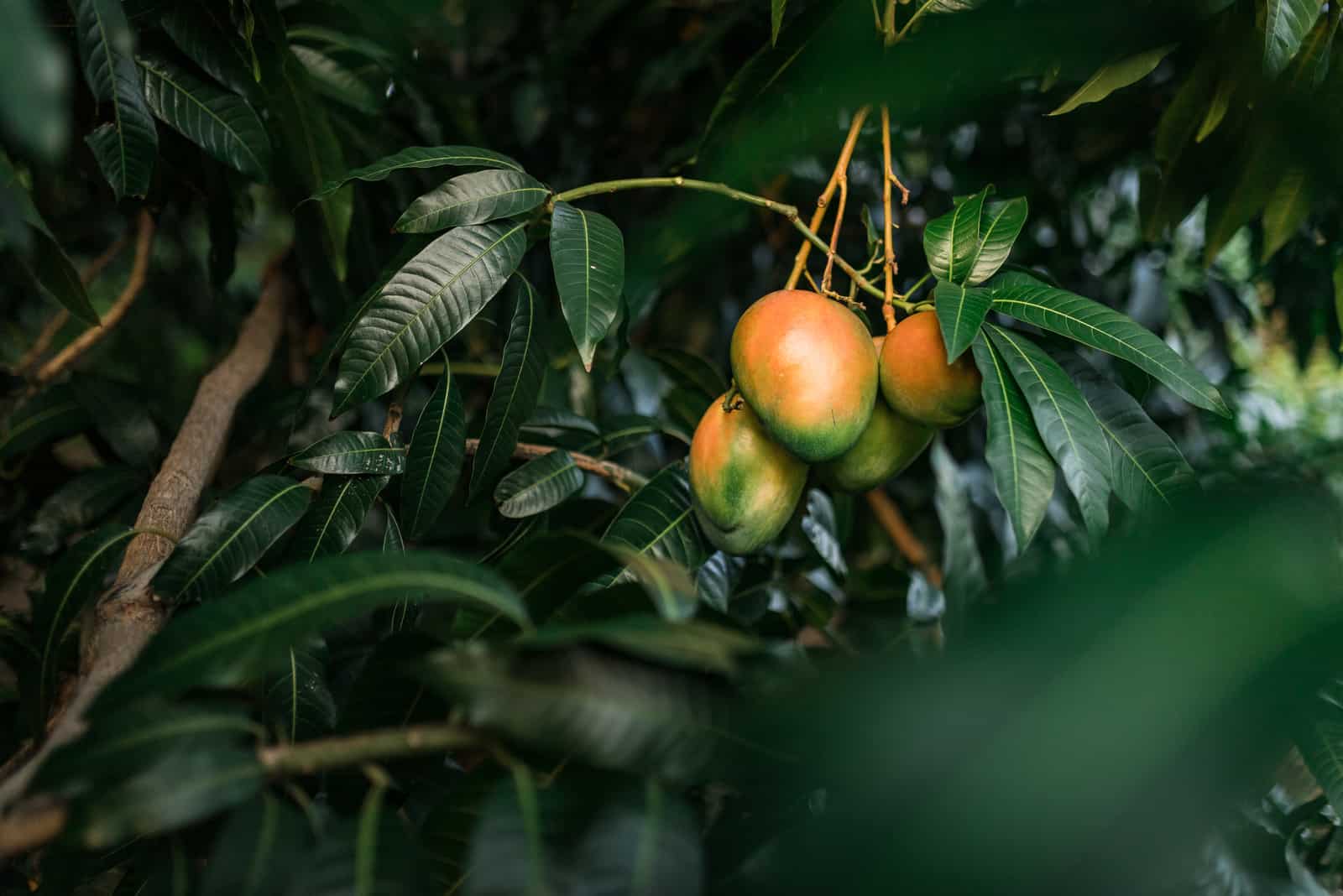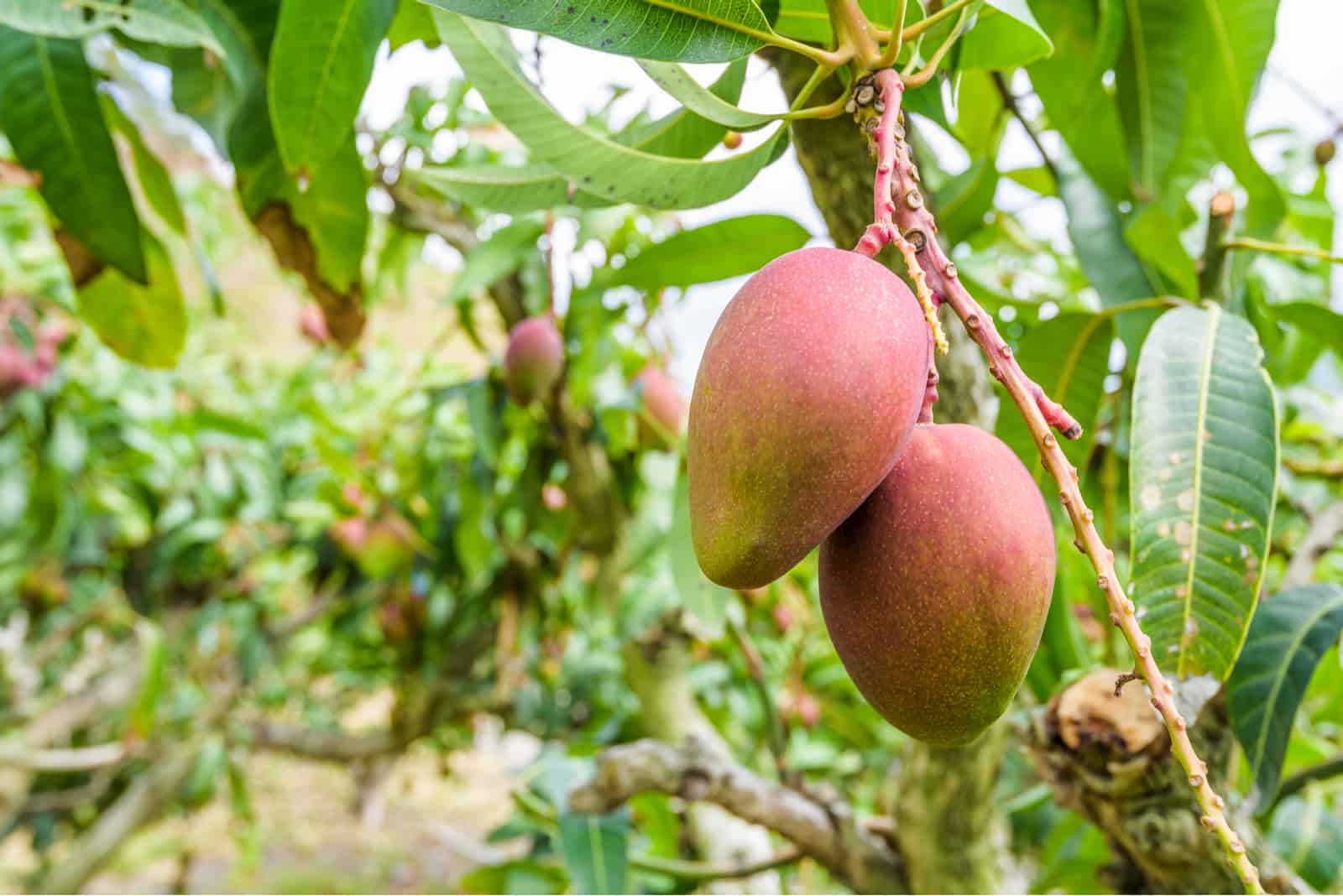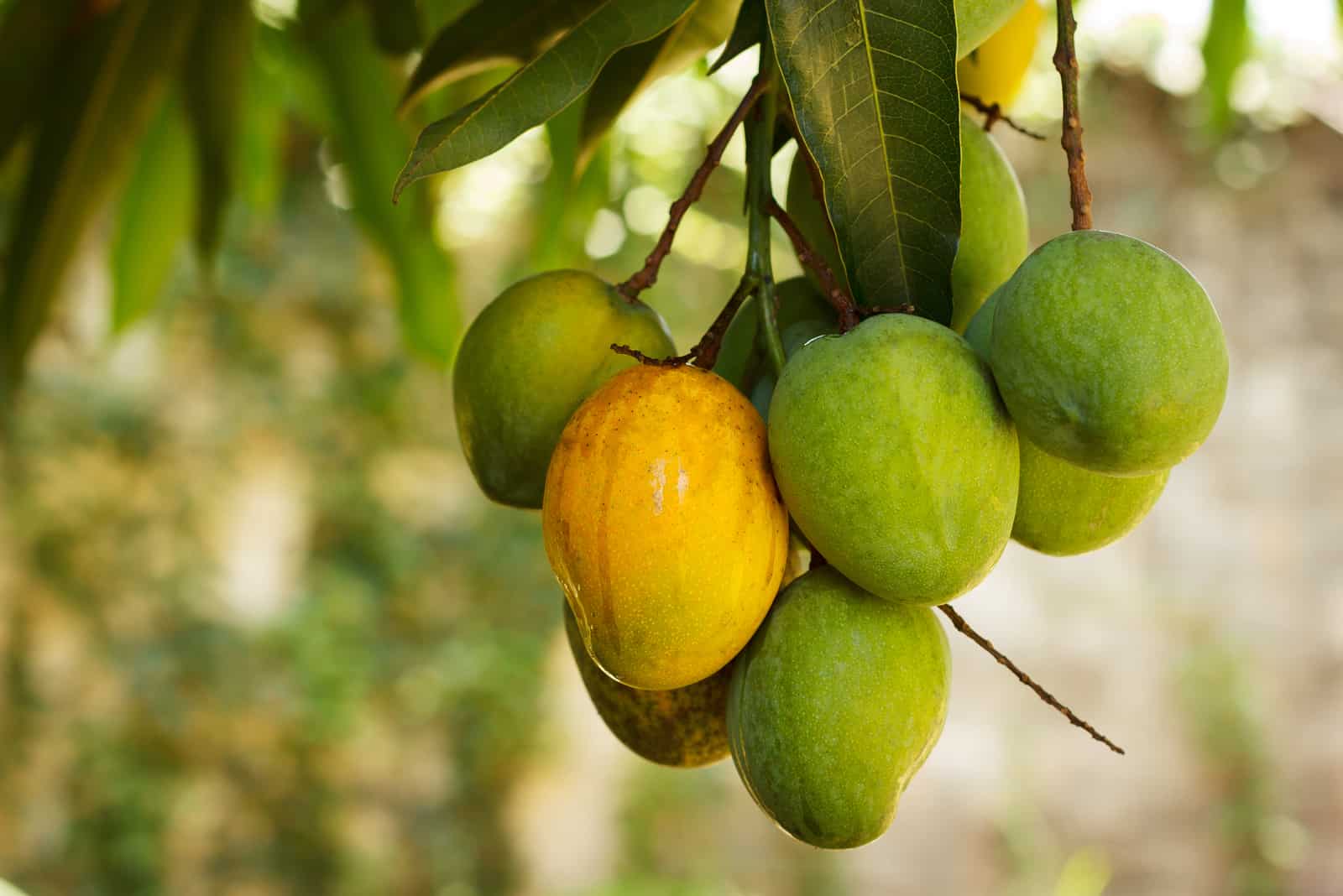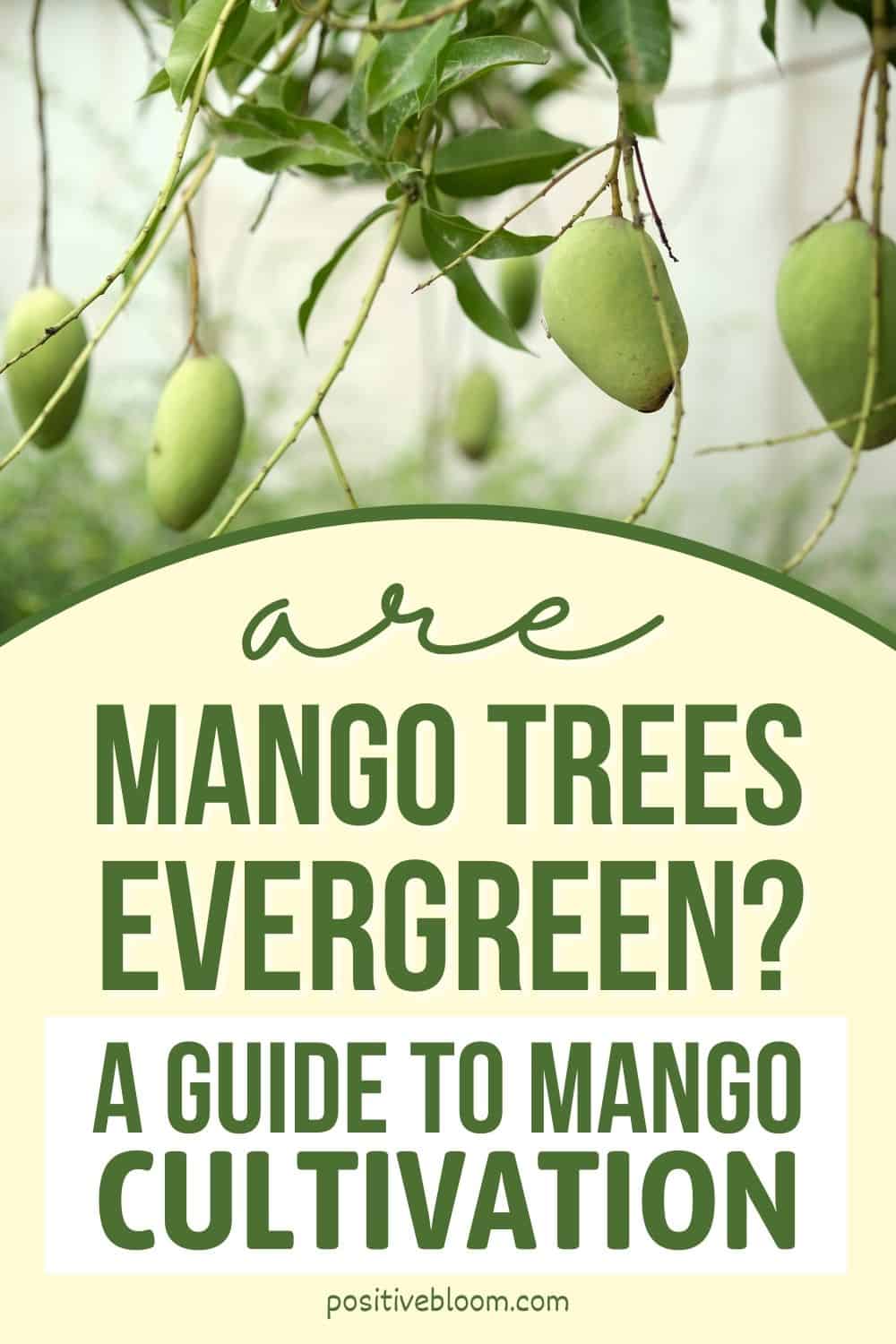The taste of sweet mango fruit is one of the best things you can have on a hot summer day. That’s why we decided to let you in on some mango secrets, so that you can grow your own and have an infinite supply of mangos all year long.
One of the recurring questions about the mango is “Are mango trees evergreen?” and we have decided to resolve this dilemma once and for all.
But, before we dive into this article, let’s look at some of the main specifics about mangos:
[table id=161 /]
We’ve decided to bring you a complete guide to mango farming, which is why we’ll bring you the answers to all the questions you might have.
The most important one, is whether the mango tree is a deciduous tree or an evergreen one, but there are also many other questions closely tied to this one.
In this article, you can also learn which states you can grow mangos in, which climates it prefers, what the best mango varieties are, and many more facts.
Finally, we have decided to include some fun facts about mangos and a short care guide, in case you already have a mango fruit graft.
Now, let’s get to know mango trees!
Are Mango Trees Evergreen?
Mango trees are evergreen trees, but they do drop their leaves from time to time, like many deciduous trees. They are classified as evergreen trees as their foliage doesn’t change its color to orange, red, or yellow in fall.
However, an interesting thing about mangos is that they do drop their leaves, however, they are not constrained to a particular season, such as fall, like other deciduous trees.
They are not highly deciduous, but they still drop their foliage periodically, and you may find yourself standing in a pile of mango tree leaves, wondering how they came to be there.
Therefore, we can say that mango trees are evergreen, with a deciduous habit; evergreen because they don’t lose their foliage in fall and winter specifically, and because their foliage doesn’t become orange or red; but deciduous because their mature leaves and ripe fruit will fall off.
3 Reasons Why Mango Trees Lose Leaves
There are three main reasons why mangos lose their foliage, and they are not all related to stress. Mangos can be classed as deciduous trees, which means that their leaf drop is a natural process.
In the following section, we’ll discuss the three most common reasons for the loss of mango leaves, so that you’ll know how to prevent them dropping if you hate cleaning your yard or orchard every so often.
1. Weather Changes
Extreme temperature swings are one of the main reasons why your mango tree drops its leaves. Established trees can tolerate temperature changes better than young mango trees, which need to be highly protected.
A sudden change from hot to cold weather causes tremendous stress to the plant, which then drops its leaves in return.
However, extreme temperatures on their own can lead to leaf drop and frost damage is the leading cause. Large and established mangos can recover from this damage, but you’ll need to pay special attention to them and water them thoroughly.
Heat is not as bad, as it doesn’t cause as severe damage to the tree as frost does. However, it can burn the tree’s foliage, which then turns brown and drops. Thankfully, these leaves are soon replaced with new leaves, and there is rarely any lasting damage, especially if the tree is well-established.
2. Shortage Of Water
Mango trees are relatively drought-tolerant, but they need regular watering to stay healthy, especially young trees which should be protected from stressors as much as possible.
Mango is a tropical tree, and it needs around 26 gallons (98 liters) of water during its first two years. If you allow the new trees to dry out, they can suffer some damage, which can be challenging to recover from.
3. Replacing Old Leaves
The mango’s leaves are partly deciduous, meaning that this tree drops its leaves throughout the year, even though they don’t change in color.
New leaves replace mature leaves, and once the new leaves mature, they dry out and drop.
However, this shouldn’t worry you, as mangos aren’t highly deciduous, and they don’t lose all their leaves at once. A leaf or two here and there presents no issue for your leaf blower, and you can rest assured that the conifer green crown will remain vibrant all year long.
How To Stop The Dropping Of Mango Leaves?
There are certain things you can do to ensure that your mango tree loses as few leaves as possible. It will lose some leaves due to its deciduous nature, but if you grow this tree in the right conditions, there won’t be lots of leaves for you to clean.
Leaf drop indicates that a plant has to spend more energy on vegetative growth, which may result in fewer blossoms, so you’ll want to do everything you can to reduce foliage drop to a bare minimum.
In the sections below, we’ll examine the three main things you need to implement if you want to see an almost inconceivable foliage drop.
Ensure Good Air Circulation
Mango trees have large symmetrical canopies, and they need plenty of spacing to flourish and minimize their leaf drop.
Therefore, you shouldn’t plant them near buildings and other plants, as the branches can cause damage to nearby things.
Also, if you live near the coast, where tempests are not unheard of, it wouldn’t be a bad idea to build a windbreak to protect your mango fruit trees.
Reduce Temperature Swings To A Minimum
Mangos are sensitive to temperature changes, especially to cold temperatures, which is why they should be cultivated in frost-free climates.
However, if you grow one in colder climates, there are certain things you can do to protect your mango tree and its foliage.
One of the best options is to grow mangos in containers and take them inside when the temperatures drop below 30 °F (-1 °C).
However, if you have a mango orchard and can’t move the trees, you can always mulch the ground around them, water them regularly, and put a frost blanket over them to keep them warm and safe.
Also, try not to use a plastic frost blanket, as the condensed water will freeze in the morning and damage the trees.
Here’s everything you need to know about mulching mango trees:
Water Regularly
Finally, watering mangos regularly is key to having an intact canopy with plenty of leaves on it.
Young trees should be watered every two to three days and, after they get established, you can reduce the watering.
Established mango trees need to be watered only during the stages of blooming and fruit production, which will maximize the number of flowers and the overall yield.
Growing Mango Trees In Different States
Mangos are usually grown in tropical climates, and when this translates to U.S. territory, we get mango trees in Hawaii, Puerto Rico, southernmost parts of Florida, and California.
Florida is one of the greatest mango producers in the USA due to its dry air and warm temperatures. Floridian mangos are in bloom from December to April, they ripen around May, and the mango tree produces fruit until October.
Mangos can also be cultivated in Georgia and Texas, whereas in New York, there’s only a 20% chance that the graft will take, so people don’t usually grow mangos there.
Growing Mango In Different Climates
Even though mango is a tropical tree and prefers tropical climates, it can survive in various temperatures. It thrives in warm, temperate, tropical, and subtropical climates, but it can survive in other environments with a few amendments.
Mango trees grow best in USDA zones 10 and 11, but they can survive in the USDA 9 zone in the South if you give them winter protection.
However, you can grow mangos pretty much anywhere; all you need is a greenhouse to meet all their requirements and to keep the temperatures above 40 °F (4 °C) at all times.
Here’s a video on how to protect mango trees in winter:
Generally speaking, mangos can be grown anywhere the climate is somewhat dry. The rainy regions are often a breeding ground for a fungal disease called anthracnose, which destroys blooms and young fruit and is rather difficult to control.
Mediterranean Climate
You can grow mango fruit in a Mediterranean climate with a few adjustments. You’ll need to remove the early flowers using plant hormones until the spring temperatures are warm enough, which will result in an increase in the yield, eventually.
Also, it’s a great idea to erect a net over mango trees to reduce sunburn and leaf drop.
Finally, you should plant varieties that are more suitable to Mediterranean temperatures and climates, such as the Dasheri and other north Indian types.
Different Mango Varieties
The Haden mango is one of the most famous mango varieties and is amongst the first ones to be grown in Florida. Later, it became the parent of many mango cultivars grown today. Nowadays, it is mainly cultivated in Mexico, Ecuador, and Peru, and it reaches its peak from March to May.
Another species of this delicious fruit is the Kent, which originated from Florida in the 1940s. Today, the leading distributors are Peru, Mexico, and Ecuador, where this variety reaches its peak in December, January, and February.
The oblong fruit of the Francis mango is characteristic of the Haitian islands, one of its main producers. Unlike previous varieties, which exhibit ripeness through their red tones, the Francis mango turns yellow when it’s ready to be eaten, and its peak availability is from May to June.
Fun Facts About Mangos
Mangos are an incredibly delicious fruit with a thought-provoking history and origin. In this section, we’ll bring you some of the most interesting facts about this fruit.
If you can spare a few minutes of your time, you’ll learn some exciting things about the origin of this fruit, its appearance, and some things about its toxicity.
Origin And Background
Mango is an edible, and may we add, heavenly, fruit that is a member of the Anacardiaceae family. Mango’s health benefits are numerous, from keeping your bones healthy and fighting cancer to weight loss.
It originates from India, Pakistan, and Myanmar, where it’s been cultivated since 2000 B.C. From there, it was introduced to the Philippines and Southeast Asia in the 5th century, and within the last 500 years, it has been cultivated throughout Africa and Brazil.
India is the world’s most significant mango producer in the modern world, and it produces around 63% of the world’s crop. Mexico, the Philippines, Pakistan, and China are other popular mango producers that bring mango fruits to our doorsteps.
Appearance Of Flowers And Foliage
Mango blossoms are produced in panicles, each 4-16 inches (10-40.5 cm) long. Their small, white flowers have five petals that spread a mild, sweet fragrance around them.
Their blooming season lasts from December to April, and mango trees can produce thousands of blooms, but not all of them can set fruit.
It usually takes around four or five months for the fruit to fully ripen after pollination.
Foliage
The foliage is one of the most prominent features of mango trees if you don’t count the fruit. The leaves grow in clusters and form a symmetrical canopy.
Young mango leaves are purple-red, and they differ from the mature leaves that we’re used to seeing. However, as they mature, mango leaves get their distinct broad-leaf shape, with a glossy and dark green topside and a somewhat duller and paler underside.
The elliptic, and sometimes even lanceolate, leaves are leathery in texture and have a pale and distinct midrib with thin, horizontal lines.
Toxicity
Mangos aren’t highly toxic, but they do contain urushiol, a poisonous substance that all members of the Anacardiaceae family possess.
However, this substance isn’t found in the sweet flesh of the mangos but rather in its skin and sap. Therefore, you should always wash it before cutting one, especially if you’re more prone to skin irritations.
Also, remember to always sterilize your tools after cutting mangos, and always wear gloves as a precaution, since urushiol is found in the tree sap as well.
Short Care Guide To Growing Mangos
In the following section, we’ve decided to present you with a short care guide for growing mangos, as proper maintenance will make sure that your trees retain as many leaves as possible.
Even though this tree doesn’t require much maintenance, there are certain things you can do to keep your mango tree healthy and increase its harvest.
Light Requirements
Mango is a tropical fruit that loves dry and hot climates, thriving in the full sun. Therefore, you should plant it somewhere where it can get at least eight hours of sunlight every day.
If the trees don’t get enough sunlight, there won’t be many flowers, and the fruit won’t taste as sweet.
The best option is to grow it outside, but if you’re keen on growing mango trees inside, you should keep them near a south-facing window.
Water And Humidity
Mango trees need water to thrive, but too much water can cause more harm than good. You can water young trees every few days, but established trees generally don’t need to be watered unless there is a long dry spell.
Also, mango trees flourish in moderate humidity levels, so if you grow this fruit indoors, you should ensure that the humidity level is always around 50%.
If your home is drier than this, you can always mist the foliage every once in a while.
Temperature
The mango is a tropical tree, and as such, it prefers warm temperatures. You should always try and keep the temperature above 70 °F (21 °C) as cold temperatures can cause flower and leaf drop.
However, mangos can tolerate lower temperatures, but anything below 30-40 °F (-1 to 4 °C) can cause severe damage to the trees and will definitely result in leaf and blossom drop.
Therefore, if you’re growing mango trees in colder climates, always ensure you cover them with something during winter to protect them from frost.
Soil And Fertilizer
Mango trees thrive in acidic to neutral soil with a pH level between 4.5-7.0. You can grow it in lateritic, sandy loam, sandy, and alluvial mediums, and it will thrive in all of them.
The soil just needs to be rich in nutrients and organic content and well-draining, for a mango tree to prosper.
The best fertilizers for mango trees are organic fertilizers, such as cow dung or fish emulsion, as you don’t have to be extremely careful with the dosage; you can also get loam-based composts or make your own.
However, you can also use chemical fertilizers, but ensure you don’t over-fertilize your trees. Young trees need to be fertilized monthly during the growing season and should receive between ¼.1 lb (100-500 g). Established trees need to be fertilized three or four times a year, or even less if the soil is very fertile.
Propagation
Mango trees can be propagated from grafts or mango seeds, but you should bear in mind that if you propagate this tree from seeds, it might not retain the same taste as the original fruit.
That’s why most of us resort to propagation through seedlings. You need to tend to them more in the first few months, but once you get an established tree, you only need to water it when the season is particularly dry and ensure that it gets plenty of sunlight.
Frequently Asked Questions
In the following section, we’ll bring you the answers to the most common questions you’ve asked us.
We couldn’t address all of them, but the following questions will give you some more information that we didn’t focus on in the article.
Do mango trees survive winter?
Established mango trees can survive cold temperatures in winter, but anything lower than 25 °F (-4 °C) will kill the tree.
Therefore, you should ensure some kind of protection for this plant; you can cover it with a frost blanket, mulch it, or even put some heat lamps around it to keep it nice and warm.
You should also provide your mango tree with plenty of water and don’t expose it to any stress, as this can lead to leaf drop.
What is the difference between a deciduous and an evergreen tree?
Deciduous trees change the color of their foliage in fall and lose their leaves during the dry season and in winter.
The foliage of evergreen trees, on the other hand, remains green all year long, and the trees don’t lose all of their leaves.
However, this doesn’t mean that evergreen trees never lose their leaves. Old leaves are replaced by new ones, but it never happens all at once, and you won’t see an evergreen tree with bare branches, unlike a deciduous tree.
Do mango trees have leaves?
Yes, mango trees have leaves that form great canopies. They are usually dark green, but young leaves can be purple-red, and as they mature, their color darkens.
They drop once they get old or if the plant is exposed to specific stressors, such as extreme temperatures, drought, or poor aeration.
What color are mango trees in winter?
Mango trees are green in winter as their conifer leaves don’t change color in fall.
If you want them to stay green and retain their foliage, you should keep the trees warm if you don’t live in a region with tropical or subtropical climates.
Summing Up
This article has brought you many facts about mangos, but the most important one was the answer to the question, “Are mango trees evergreen?”.
You now know that mango trees are evergreen, and you’re familiar with the most common reasons for mango leaf drop.
We gave you some tips on how to help your trees retain their foliage during winter and introduced you to some fun facts about mangos, such as their origin, appearance, and the toxicity of their skin and sap.
Finally, we brought you a short care guide for cultivating mangos, since proper care will ensure that your tree doesn’t lose more leaves than it should.
Now we can only wish you good luck in growing mangos and until next time!
Like this post? Share or pin it for later!

